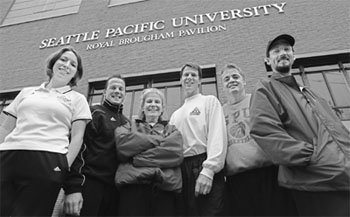By Hope McPherson
Photos by Jimi Lott


SPU Joins Other Northwest Schools
in Forming GNAC

In January 1997, the Seattle Pacific University men's basketball team crisscrossed time zones and state lines at a grueling pace. The Falcons played six teams in two weeks — two in Hawaii, one in New Mexico, one in Montana, two in Alaska. "We lost all six games," recalls Head Coach Ken Bone. "It was the only time in eight seasons we didn't make it to the NCAA Tournament."
Such exhausting road trips are now history. Last season, several NCAA Division II universities in the Pacific West Conference, including SPU, discussed withdrawing from the PacWest to form a new conference. Rather than spanning three regions and four time zones, the conference would include only universities in the Northwest. On September 1, 2001, the Great Northwest Athletic Conference (GNAC) officially gained NCAA recognition.
"I'm ecstatic about being in this new conference," says Bone, whose team will play its first GNAC game against Central Washington on December 6.
Ten universities strong, the GNAC includes both private and public institutions. Members include universities in Washington, Oregon, Idaho, Northern California and Alaska. "Geographically, these universities felt they'd make a much better union than the PacWest," says Richard Hannan, new GNAC commissioner. Until this year, all had been PacWest members along with schools in Hawaii, New Mexico and Montana.
"There are still the same rivalries and the same competition," says Kellie Radloff, SPU volleyball coach. "It's just cleaner - and not in two regions."
Seattle Pacific Athletic Director Tom Box agrees. "We had a melting pot in the PacWest and we were all attempting to be inclusive with the more distant schools. It became clear that 16 teams was too big," he explains, noting that long and costly road trips caused student-athletes to miss too much class time during their seasons.
About the lamentable 1997 men's basketball road trip, Bone says, "The players missed nine out of 14 days of school, right in the middle of their quarter."
As the GNAC came together in late 2000, member universities developed a new camaraderie, adding a dimension to their rich tradition of athletic rivalries. Colleagues across the soon-to-be conference guided the GNAC's formation, and many were from Seattle Pacific.
 Box served on several GNAC committees and became the official GNAC spokesman once
its organization was announced. Bob Huber, SPU associate athletic director, likewise collaborated on countless conference details. Former commissioner of
the Western Athletic Conference and 1952 Seattle Pacific alum Joseph Kearney
served as a consultant. SPU graphic designer Theresa Martin designed the conference logo.
Box served on several GNAC committees and became the official GNAC spokesman once
its organization was announced. Bob Huber, SPU associate athletic director, likewise collaborated on countless conference details. Former commissioner of
the Western Athletic Conference and 1952 Seattle Pacific alum Joseph Kearney
served as a consultant. SPU graphic designer Theresa Martin designed the conference logo.
And Seattle Pacific support went to the top. "I was very impressed with President Eaton's view of the conference and his articulation of the importance of it," says Commissioner Hannan.
Now that the 2001-2002 athletic season is underway, players and coaches are enjoying the change. A fourth-year volleyball player and senior, Lesley Kamphouse won't miss long road trips. "Travel is physically and mentally draining, especially going across time zones," she says, adding that the hours spent in airports were particularly brutal.
She will miss travel to Hawaii, however. "It was always a fun trip," says Kamphouse. "It's like being in a different country."
While Hawaii may be off the conference schedule, Alaska is on. And Bone's basketball players are eager to head north. "It's a trip they'll never forget," he says, "and that's part of the college athletic experience."
He's also quick to point out the benefits of the GNAC to local fans. "Alums and fans can now drive 15 to 20 minutes to see a conference game," he says.
All in all, it's the makings for a win-win season. "We have the pieces of something that will last a long time," says Box. "This is not an interim step. This is a long-term solution."
![]()

| Please read our
disclaimer.
Send any questions, comments or correspondence about Response to jgilnett@spu.edu or call 206-281-2051. Copyright © 2001 University Communications, Seattle Pacific University.
Seattle Pacific University |